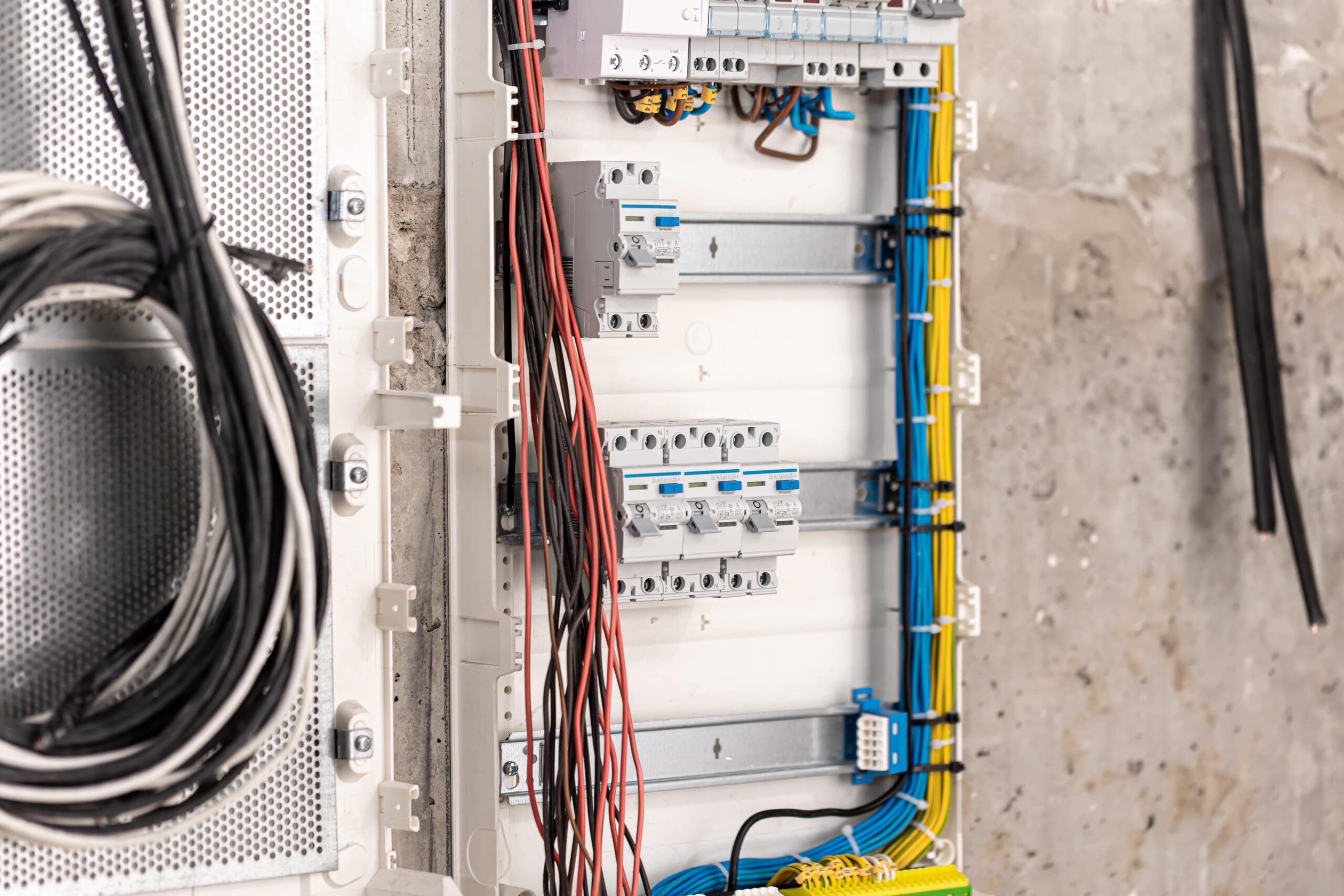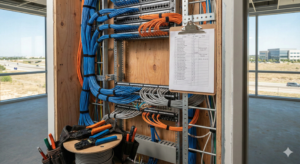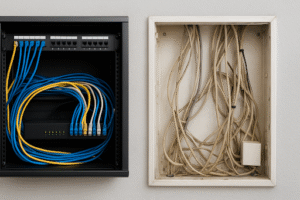Low-voltage cabling works quietly behind the walls, powering the tech we rely on every day. Take a look around any modern building, and chances are it’s powered by more than just high-voltage electricity. From doorbells and CCTV systems to data cabling and energy-efficient lighting, low-voltage electrical systems are doing the heavy lifting behind the scenes. So, what does low voltage mean? And why should anyone working on construction, remodeling, or smart building upgrades care about it?
What Does Low Voltage Mean?
Let’s start with a basic question: What voltage is low voltage? Low-voltage electrical systems operate at 50 volts or less. That ultimately means they are comprised of electrical equipment that uses 50 volts (V) of electricity or less. Common low-voltage examples include 12V, 24V, and 48V systems. The low voltage definition helps differentiate these systems from standard line-voltage electrical systems (usually 120V or 240V in the U.S.).
In simple terms, low voltage means electricity that’s powerful enough to run systems like lighting or communication but not strong enough to cause serious harm. It’s safe, flexible, and ideal for delicate electronics.
Common Low-Voltage Systems Examples
Low-voltage tech is as prevailing in the 21st century as high-voltage voltage tech is, and even more. Low-voltage systems are used everywhere. Here are some popular low-voltage system examples:
- Doorbells and Intercoms
- Thermostats and HVAC Controls
- Security Cameras and Alarm Systems
- Wi-Fi and Ethernet Data Cabling
- Landscape and Accent Lighting
- Fire Alarm and Access Control Systems
These systems typically use a fraction of the energy compared to traditional electrical devices, which is why low-voltage house wiring is gaining popularity in both residential and commercial spaces.
What Is Considered Low Voltage Wiring?
What is considered low-voltage wiring depends on the application. But typically, it includes:
- Cat5e/Cat6 cables for networking
- Coaxial cables for video
- Twisted pair wires for telecom
- Speaker wire for audio
- 18/2 thermostat wire for HVAC
Think of them as the vein system of the human body: small but very important. In all cases, these wires are smaller, easier to manage, and not designed to carry high currents. They’re built for communication and control, not heavy-duty power delivery.
Components of an Electrical Low-Voltage System
A modern electrical low-voltage system isn’t a single component, it’s an interconnected network of:
- Structured cabling
- Power supplies (12V, 24V)
- Sensors, controllers, and hubs
- Low-voltage light fixtures
- Backup batteries or UPS units
These components work together to organize lighting, security, climate control, and communication.
What Is Low-Voltage Electrical Work?
What is low-voltage electrical work is in explanation not that difficult. In short, it includes the planning, installation, and maintenance of systems that run on low-voltage wiring. Licensed electricians or low-voltage technicians often handle this work. It’s different from general electrical contracting because it deals more with technology, signal flow, and system integration.
Low-voltage work is especially common in smart homes, commercial buildings, and schools, where everything from projectors to door access systems needs a stable, low-power connection.
Choosing the Right Cabling
Picking the right cable matters a lot. It either proves as a strength or a weakness for your system. You need to know:
- Voltage requirements (12V vs. 24V, for example)
- Frequency needs (e.g., Cat5e at 100 MHz, Cat6a at 500 MHz)
- Location safety (plenum-rated vs. riser vs. general purpose)
The NEC provides clear guidance, but so does experience. Knowing what is considered low-voltage wiring helps you avoid the costly mistake of using the wrong type.
Why It Matters in Construction
Low-voltage systems aren’t just additional appendages anymore, they’re part of the core infrastructure. Integrating low-voltage electrical systems early in construction means less retrofitting later and smoother operation for:
- Fire alarms
- Data centers
- Security and access control
- Energy-efficient lighting systems
Advantages of Low-Voltage Systems
Let’s highlight a few undeniable perks:
- Safety: Lower voltage leads to lower risk of shock.
- Energy Efficiency: Great for green building projects.
- Flexibility: Easy to upgrade or expand.
- Cost-Effective: Materials and labor usually cost less.
- Versatile Applications: From lighting to data to climate control.
The lowest voltage systems still pack a punch when it comes to functionality, especially when layered into smart building setups.
Conclusion: Why You Should Care
I hope it is now clear to you what low voltage means in the electrical world. If you’re managing a building, renovating a home, or launching a new construction project, understanding low-voltage electrical systems could save you time, money, and a lot of headaches.
To sum up, the integration of low-voltage systems in construction has also become an integral aspect of modern building projects. And these aren’t just wires and boxes, they’re the infrastructure that connects, automates, and protects the environments we live and work in.When done right, low-voltage electrical planning ensures your space is not only functional but future-ready.





